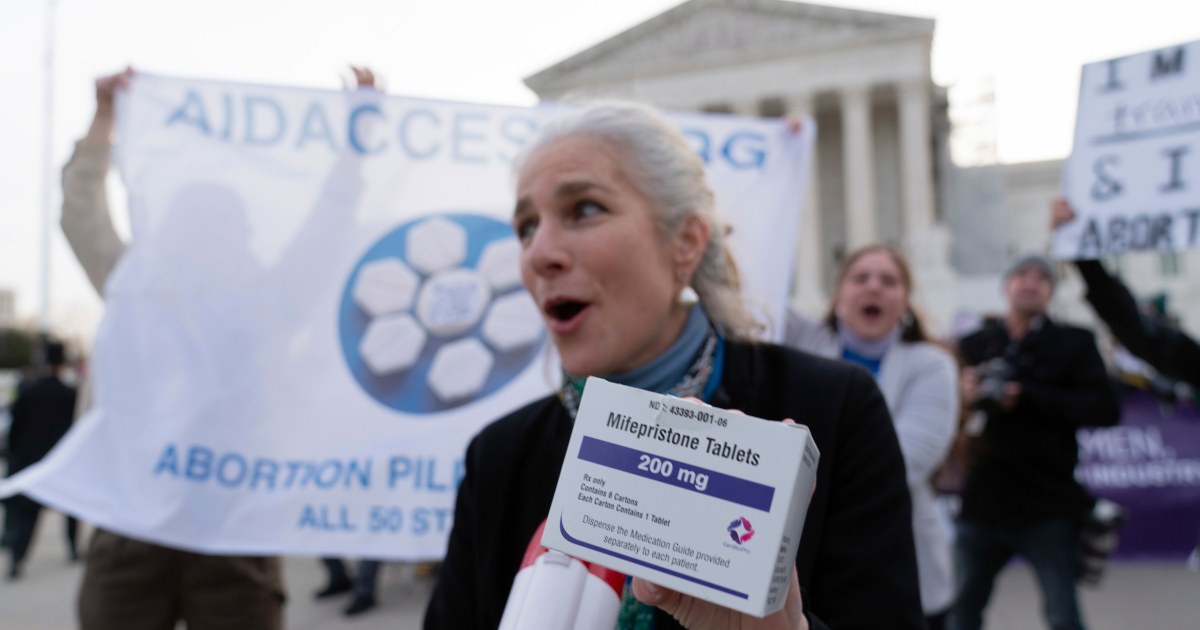By Mark Sherman—
The Associated Press
Supreme Court justices were skeptical Tuesday about whether litigants seeking to restrict access to the abortion pill mifepristone have the legal right to sue.
The pill, which is used in more than 60% of abortions in the United States, has been at the center of a legal battle since the justices overturned Roe v.
Wade two years ago.
After hearing arguments about the FDA's actions that made the pill more accessible more than two decades ago, the justices skeptically suggested
that the court could leave in place current rules
that allow patients to receive the drug by mail, without needing from an in-person medical visit, and taking it to induce an abortion, up to 10 weeks of pregnancy.
Attorney General Elizabeth Prelogar, Joe Biden's administration's lead lawyer before the Supreme Court, said the court should make clear that doctors and anti-abortion organizations who challenged the FDA's loosening of restrictions on purchasing mifepristone are not " not even 100 miles” from having the legal right, or legitimacy, to sue.
Abortion opponents are asking judges to uphold a ruling by a conservative federal appeals court that would limit access to mifepristone, one of two drugs used in medical abortions.
Abortion rights activists demonstrate in front of the Supreme Court, Tuesday, March 26, 2024, in Washington.
Jose Luis Magana / AP
The highest court's return to abortion dynamics occurs in a political and regulatory landscape reconfigured by the 2022 decision, which led many Republican-led states to ban or severely restrict abortion.
That ruling had immediate political consequences, and the outcome in the new case, expected in early summer, could affect congressional and White House elections.
The scene outside the Supreme Court was lively Tuesday morning, with protesters occupying the streets and groups from both sides chanting.
Police also blocked traffic around the court.
The practical consequences of a ruling for abortion opponents would be dramatic, since it would possibly paralyze the delivery of mifepristone by mail and in large pharmacy chains, it would reduce the period of pregnancy in which it can be used from 10 to seven weeks and it would put an end to the increasingly popular telehealth consultations in which the drug can be prescribed.
President Joe Biden's administration and drug makers warn that such an outcome could also undermine the FDA's drug approval process more broadly by inviting judges
to question the agency's scientific judgments.
Anti-abortion doctors and other medical organizations argue that the FDA's decisions in 2016 and 2021 to relax restrictions on obtaining the drug were unreasonable and “endanger the health of women across the country.”
The Democratic Administration and New York-based Danco Laboratories, which manufactures mifepristone, have assured that the drug is among the safest the FDA has approved.
In a possible resolution, the justices could avoid touching on the most politically sensitive aspects of the case, while preserving access to mifepristone.
The Administration and Danco maintain that the plaintiffs lack standing to file a lawsuit.
If the Supreme Court agrees with them, it will basically dismiss the case and overturn the appeal ruling.
There is already another abortion case on the agenda.
Next month, the justices will debate whether a federal law on emergency hospital treatment should cover abortions, even in states that ban them.
[From in vitro fertilization to birth control: the abortion pill case in the Supreme Court could trigger challenges to other drugs]
The mifepristone case began five months after the Supreme Court overturned Roe v. Wade.
Abortion opponents initially obtained a sweeping ruling nearly a year ago from U.S. District Judge Matthew Kacsmaryk, a Trump nominee in Texas, that would have completely revoked approval of the drug.
The US Court of Appeals for the 5th Circuit left the FDA's initial approval of mifepristone intact.
But it would reverse changes regulators made in 2016 and 2021 that eased some conditions for administering the drug.
The Supreme Court put the appeals court's modified ruling on hold, then agreed to hear the case, although Justices Samuel Alito, author of the decision that overturned Roe, and Clarence Thomas would have allowed some restrictions to take effect while the case continued its course.
Mifepristone is one of two drugs, along with misoprostol, used in medical abortions.
Its use has been increasing for years.
More than 6 million people have used mifepristone since 2000. Mifepristone is first taken to dilate the cervix and block the hormone progesterone, necessary to maintain pregnancy.
Misoprostol is taken 24 to 48 hours later, so that the uterus contracts and expels pregnancy tissue.
Health professionals have stated that if mifepristone became unavailable or too difficult to obtain, they would switch to using only misoprostol, which is somewhat less effective in terminating pregnancy.

